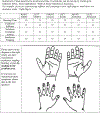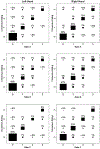Reliability of hand diagrams for the epidemiologic case definition of carpal tunnel syndrome
- PMID: 18521726
- PMCID: PMC9012995
- DOI: 10.1007/s10926-008-9139-y
Reliability of hand diagrams for the epidemiologic case definition of carpal tunnel syndrome
Abstract
The purpose of this study was to evaluate the inter-rater reliability of hand diagrams, which are commonly used in research case definitions of carpal tunnel syndrome (CTS). To evaluate the potential of non-random misclassification of cases, we also studied predictors of rater disagreement as a function of personal and work factors, and of hand symptoms not classic for CTS. Participants in a longitudinal study investigating the development of CTS completed repeated self-administered questionnaires. Three experienced clinicians, blind to subjects' work or personal history, independently rated all hand diagrams on an ordinal scale from 0 to 3. Disagreements between ratings were resolved by consensus. Reliability was measured by the weighted kappa statistic. Logistic regression models evaluated predictors of disagreement. Three hundred and thirty-three subjects completed 494 hand diagrams. Eighty-five percent were completed by self-administered questionnaire and 15% by telephone interview. Weighted kappa values representing agreement among the three raters, were 0.83 (95% CI: 0.78, 0.87) for right hand diagrams and 0.88 (95% CI: 0.83, 0.91) for left hand diagrams. Ratings from hand diagrams obtained by telephone interview produced better agreement. Agreement among raters was not affected by subjects' personal or work factors. Disagreement among raters was associated with the presence of hand/wrist symptoms other than classic CTS symptoms. Overall, high levels of agreement were attained by independent raters of hand diagrams. Personal factors did not affect agreement among raters, but presence of non-CTS symptoms seemed to affect results and should be considered in studies focused on diverse populations with heterogeneity of upper extremity symptoms.
Figures
Similar articles
-
Katz and Stirrat hand diagram revisited.Hand Surg. 2010;15(2):71-3. doi: 10.1142/S0218810410004667. Hand Surg. 2010. PMID: 20672392
-
A self-administered hand symptom diagram for the diagnosis and epidemiologic study of carpal tunnel syndrome.J Rheumatol. 1990 Nov;17(11):1495-8. J Rheumatol. 1990. PMID: 2273490
-
Diagnosing Carpal Tunnel Syndrome: Diagnostic Test Accuracy of Scales, Questionnaires, and Hand Symptom Diagrams-A Systematic Review.J Orthop Sports Phys Ther. 2020 Nov;50(11):622-631. doi: 10.2519/jospt.2020.9599. Epub 2020 Sep 16. J Orthop Sports Phys Ther. 2020. PMID: 32938312
-
Interview data versus questionnaire data in the diagnosis of carpal tunnel syndrome in epidemiological studies.Occup Med (Lond). 2003 Feb;53(1):57-63. doi: 10.1093/occmed/kqg010. Occup Med (Lond). 2003. PMID: 12576567
-
Carpal tunnel syndrome: validation of an interview questionnaire on occupational exposure.Am J Ind Med. 1998 Mar;33(3):224-31. doi: 10.1002/(sici)1097-0274(199803)33:3<224::aid-ajim3>3.0.co;2-w. Am J Ind Med. 1998. PMID: 9481420
Cited by
-
General population job exposure matrix applied to a pooled study of prevalent carpal tunnel syndrome.Am J Epidemiol. 2015 Mar 15;181(6):431-9. doi: 10.1093/aje/kwu286. Epub 2015 Feb 19. Am J Epidemiol. 2015. PMID: 25700886 Free PMC article.
-
Diagnostic strategies using physical examination are minimally useful in defining carpal tunnel syndrome in population-based research studies.Occup Environ Med. 2010 Feb;67(2):133-5. doi: 10.1136/oem.2009.047431. Epub 2009 Oct 22. Occup Environ Med. 2010. PMID: 19854697 Free PMC article.
-
Clinical Utility of the 6-Item CTS, Boston-CTS, and Hand-Diagram for Carpal Tunnel Syndrome.Front Neurol. 2021 Jul 27;12:683807. doi: 10.3389/fneur.2021.683807. eCollection 2021. Front Neurol. 2021. PMID: 34385969 Free PMC article.
-
Education, night splinting and exercise versus usual care on recovery and conversion to surgery for people awaiting carpal tunnel surgery: a protocol for a randomised controlled trial.BMJ Open. 2016 Sep 16;6(9):e012053. doi: 10.1136/bmjopen-2016-012053. BMJ Open. 2016. PMID: 27638495 Free PMC article. Clinical Trial.
-
Physical examination has a low yield in screening for carpal tunnel syndrome.Am J Ind Med. 2011 Jan;54(1):1-9. doi: 10.1002/ajim.20915. Epub 2010 Oct 28. Am J Ind Med. 2011. PMID: 21154516 Free PMC article.
References
-
- Atroshi I, Gummesson C, Johnsson R, Ornstein E, Ranstam J, Rosen I. Prevalence of carpal tunnel syndrome in a general population. JAMA 1999; 282:153–8. - PubMed
-
- de Krom MC, Knipschild PG, Kester AD, Thijs CT, Boekkooi PF, Spaans F. Carpal tunnel syndrome: prevalence in the general population. J Clin Epidemiol 1992; 45:373–6. - PubMed
-
- Papanicolaou GD, McCabe SJ, Firrell J. The prevalence and characteristics of nerve compression symptoms in the general population. J Hand Surg [Am] 2001; 26:460–6. - PubMed
-
- Frost P, Andersen JH, Nielsen VK. Occurrence of carpal tunnel syndrome among slaughterhouse workers. Scand J Work Environ Health 1998; 24:285–92. - PubMed
-
- Homan MM, Franzblau A, Werner RA, Albers JW, Armstrong TJ, Bromberg MB. Agreement between symptom surveys, physical examination procedures and electrodiagnostic findings for the carpal tunnel syndrome. Scand J Work Environ Health 1999; 25:115–24. - PubMed
Publication types
MeSH terms
Grants and funding
LinkOut - more resources
Full Text Sources
Medical
Research Materials



